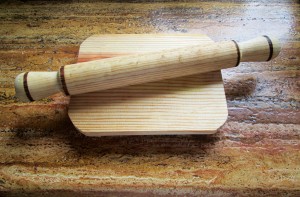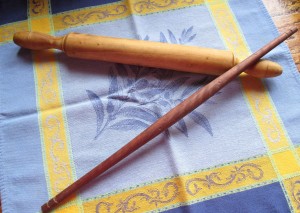A rolling pin. Of all the things one can buy at the Mercado Hidalgo, the huge, old, Quonset-hut-like structure in Guanajuato’s centro – stalls and stalls of fresh fruit and vegetables, all cuts of freshly butchered meat, small electronics, plastic toys, souvenir tee-shirts and bags (many featuring Frida Kahlo), locally made candy, handmade baskets and earthy pottery, dried beans of every size and color, artisanal cheeses, and you-name-it – I bought a Mexican rolling pin. For 45 pesos, or about $3 usd.

Which made me wonder, as I trudged back up Callejon del Cinco Señores, the steep stairway/alleyway to my temporary casa (325 steps, I counted them): WHY? Why a rolling pin? Did I plan to make my own tortillas? No. The fresh corn and flour tortillas made and sold by local women are far better than I could ever make. Was I going to roll out some buttery pastry dough to bake a French tart or an American pie? No. The kitchen’s gas oven here is on the blink. No such baking for me.
Back at the casa, I realized this new wooden rolling pin would be joining two others I’d brought with me from the States: One, a slim, tapered rolling pin I’d bought in Lecce, Italy, at a food conference I attended there in May 1995; and the other I got at a market in Marrakech, Morocco, on a food-writers’ junket a couple of years later. Why in the world had I brought these two to Mexico for the summer (leaving my bigger, favorite French-bought rolling pin at home in Taos)? Why did I need another one here? I now had three rolling pins that I wouldn’t be using. What was I thinking?

Self-examination, I believe, is one of the steps toward wisdom; and now that I’ve reached this new, lofty rung marked 70, I’m on a quest for wisdom. So I’ve had to ask myself this week: What’s with the rolling pins?
Perhaps it has to do with this:
One of the purest, most vivid, and happiest memories I have from childhood is that of watching my mother bake pies. As the eldest of her three daughters, I was, from the time I could walk and talk, her sidekick, her shadow, her helper, her disciple. Her skills in the kitchen – her favorite room in our house – were always remarkable; but her way with pastry and pies was superlative. The way her slender hands deftly handled the soft dough (“Never over-work it,” she’d tell me every time; “be quick and confident”), the way she wielded her old, rickety rolling pin (never like a cudgel, always lovingly): Starting in the center and rolling gently toward the edge, lifting and turning the dough to keep it from sticking, rolling from the center out again – these movements became the pleasanter home movies burned on my mind.
Although I grew to resemble her physically, philosophically my mother and I were always planets apart. Her life philosophy could be summed up succinctly (and I’m quoting her here): “When you’re alive, you live; when you die, you’re dead.” My own is still being formulated. I still have more questions than answers. She used to tell me that my problem was I think too much; blonds should have fun. Perhaps she was right about this too.
She never made it to 70. She died of brain cancer over 30 years ago, in her 69th year. But if she were alive – and lucid – today and if we were sitting across from each other as we used to do at her kitchen table and she’d look at me attentively yet quizzically, as if to say, Where in the word did you come from?, I’d tell her that I have a new theory: Destiny is like a rolling pin, and we are like pastry dough. Destiny rolls us and stretches us from the center out, lifts us and turns us to keep us from getting stuck in one place. We are just dough in Destiny’s loving, confident hands.
I think I know what she would do. She’d give me a wan smile, roll her eyes, pat my hand, and tell me, “Honey, you think too much.” And maybe she’d be right.
